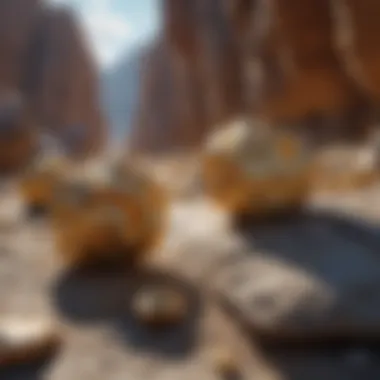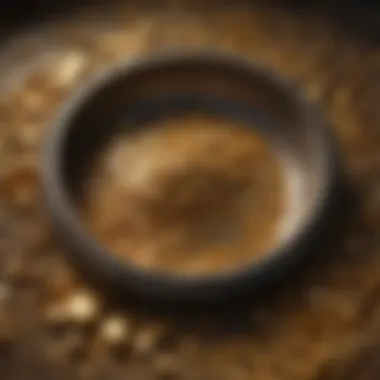Discovering Gold: Strategies to Find Precious Metal Near You


Rock and Fossil Identification
As a passionate rock and fossil collector searching for gold in your vicinity, it is vital to understand the types of rocks and fossils that may indicate the presence of gold deposits. Identifying key characteristics such as mineral composition, color variations, and texture irregularities can point you towards potential gold-rich areas. Utilizing specialized tools like magnifying loupes, rock hammers, and mineral testing kits further enhances your ability to distinguish valuable specimens from ordinary rocks.
Geological Insights
Delving into the geological aspects of gold formation is crucial for your quest to find gold near you. By analyzing geological formations and processes, such as the formation of quartz veins in metamorphic rocks or placer deposits in riverbeds, you can strategically pinpoint areas with higher gold prospectivity. Understanding the historical significance of geological formations provides insights into past gold mining activities and aids in identifying potential locations for your own exploration. Exploring notable discoveries in the field offers inspiration and valuable knowledge to guide your search for gold treasures.
Collecting Tips and Techniques
Embarking on the journey of collecting gold-bearing rocks requires adherence to best practices to ensure a successful and safe experience. By familiarizing yourself with proper collecting techniques, such as using a rock hammer to extract samples without damaging them, you can maximize your findings. Locating prime collecting sites by researching geological maps, consulting with local experts, and investigating historical mining activities can significantly boost your chances of discovering gold traces. Safely extracting specimens by employing techniques like panning in water sources or using metal detectors adds a layer of excitement and efficiency to your gold hunting endeavors.
Preservation and Display
Preserving the rocks and fossils you collect is essential for maintaining their integrity and showcasing them effectively. Implementing preservation techniques like storing specimens in airtight containers, utilizing desiccants to control moisture levels, and avoiding exposure to sunlight helps prolong their lifespan. When it comes to displaying your prized collection, explore creative ideas such as arranging specimens by color gradients, creating themed showcases, or incorporating lighting effects to accentuate their unique features. By combining preservation methods with innovative display concepts, you can elevate the visual appeal of your collection while safeguarding its longevity.
Understanding Geological Basics


Understanding Geological Basics is a foundational aspect when delving into strategies to find gold nearby. By grasping the geological context in which gold forms and deposits, individuals can significantly enhance their chances of successful exploration. This section aims to enlighten readers on the crucial role that geological knowledge plays in their gold-finding pursuits.
Introduction to Gold Formation
In the realm of gold exploration, comprehending how gold originates and forms within the Earth's crust is paramount. Gold is typically forged through complex geological processes involving high-temperature hydrothermal fluids and metamorphic environments. By understanding the formation mechanisms of gold, prospectors can target specific regions where geological conditions are favorable for gold accumulation. Apprehending the genesis of gold enables prospectors to predict its occurrence more accurately and make informed decisions during exploration.
Identifying Potential Gold-Bearing Areas
Identifying Potential Gold-Bearing Areas is a critical step in the quest to discover gold in one's vicinity. Various geological factors such as mineralization patterns, host rock types, and structural settings influence the presence of gold deposits. Prospectors need to employ geological mapping techniques to pinpoint areas with the highest potential for harboring gold mineralization. By recognizing the geological signatures associated with gold-bearing environments, individuals can focus their exploration efforts on locations more likely to yield significant gold discoveries.
Geological Indicators of Gold Deposits
Geological Indicators of Gold Deposits serve as guideposts for prospectors navigating the intricate landscape of gold exploration. These indicators include mineral assemblages, alteration zones, and structural features that signal the proximity of gold deposits. Understanding these geological clues empowers prospectors to interpret the subtle signals embedded in the earth's composition and identify potential gold-rich zones. By honing in on these geological indicators, individuals can optimize their exploration strategies and increase the likelihood of striking gold in their search.
Exploration Techniques
In the quest to find gold near you, mastering exploration techniques is paramount. The process of exploration serves as the foundation for successful gold discovery, encompassing a range of methods and tools that aid prospectors in their search. Understanding and implementing these techniques effectively can significantly increase the chances of discovering gold deposits in your vicinity. This section will delve deep into the importance of exploration techniques within the context of this comprehensive guide, highlighting specific elements, benefits, and considerations that are crucial for aspiring gold hunters.


Prospecting Tools and Equipment
When engaging in the search for gold, having the right prospecting tools and equipment can make a substantial difference in the efficiency and effectiveness of your exploration efforts. Prospecting tools such as metal detectors, gold pans, and sluice boxes are essential for detecting and extracting gold from potential sites. Equipment like rock hammers, hand lenses, and GPS devices are also invaluable in conducting in-depth geological surveys and pinpointing promising areas for further exploration. Understanding the functions and proper use of these tools and equipment is key to maximizing your chances of discovering gold deposits in your vicinity.
Sampling and Testing Methods
Sampling and testing methods play a crucial role in the gold exploration process, allowing prospectors to assess the composition and viability of potential gold-bearing materials. Through meticulous sample collection and analysis, prospectors can determine the presence of gold in geological formations and evaluate the quality of deposits. Various testing methods, including fire assays, spectrometry, and X-ray fluorescence, provide valuable insights into the concentration and distribution of gold within a given area. Mastering these methods is essential for making informed decisions and optimizing exploration efforts towards uncovering significant gold reserves.
Utilizing Satellite Imaging
In the digital age, the utilization of satellite imaging has revolutionized the field of gold exploration by offering a bird's-eye view of prospective terrain. Satellite imagery provides detailed aerial information about topography, vegetation cover, and geological structures that can indicate the presence of gold deposits. By interpreting satellite data effectively, prospectors can identify potential gold-bearing areas, plan targeted exploration campaigns, and optimize their fieldwork strategies. Integrating satellite imaging into the exploration process enhances survey accuracy, reduces exploration time, and increases the likelihood of discovering gold deposits near you.
Modern Technological Solutions
Modern Technological Solutions play a pivotal role in the realm of gold exploration, offering a blend of innovation and precision that significantly enhances the efficiency and accuracy of the search for gold deposits. Leveraging cutting-edge technologies, such as geochemical surveys, drone technology, and geophysical methods, can revolutionize the way prospectors identify and target potential areas for gold exploration.
Geochemical Surveys and Analysis


Geochemical surveys and analysis are essential components of modern gold exploration strategies. By studying the chemical composition of rocks, soil, and water in a specific area, geologists can pinpoint anomalies that may indicate the presence of gold deposits. This method provides valuable insights into the geochemical signatures associated with gold mineralization, aiding prospectors in narrowing down their search area and increasing the likelihood of a successful discovery.
Drone Technology in Gold Exploration
Drone technology has emerged as a game-changer in the field of gold exploration, enabling prospectors to conduct aerial surveys with unprecedented accuracy and efficiency. Drones equipped with high-resolution cameras and advanced sensors can cover expansive terrains rapidly, capturing detailed images and data that would be challenging to obtain through traditional ground-based methods. By utilizing drones, prospectors can gain a comprehensive view of potential gold-bearing areas, leading to more informed decision-making and optimized exploration efforts.
Geophysical Methods for Targeting Gold Deposits
Geophysical methods, such as ground-penetrating radar and induced polarization surveys, offer valuable insights into the subsurface geology of an area, helping prospectors identify structural features and potential ore bodies associated with gold mineralization. By measuring the physical properties of rocks and minerals, geophysicists can map out subsurface structures and anomalies that may indicate the presence of gold deposits. These geophysical techniques serve as powerful tools in targeting specific areas for further exploration and play a crucial role in defining drill targets for more focused prospecting efforts.
Community Engagement and Resources
In the quest for finding gold near you, community engagement and utilizing various resources play a pivotal role in enhancing your prospecting journey. Being part of local prospecting groups offers a wealth of benefits beyond just networking. By joining these groups, individuals can tap into a collective pool of knowledge and experience, gaining insights on potential gold-rich areas and best practices in prospecting techniques. Moreover, camaraderie within these groups fosters a sense of belonging and encourages collaboration, which can lead to more successful ventures. It also provides access to group outings and field trips, allowing members to explore different terrains and increase their chances of striking gold.
Joining Local Prospecting Groups
Joining local prospecting groups is a strategic move for gold enthusiasts looking to broaden their horizons and learn from seasoned prospectors. These groups serve as valuable platforms for sharing tips, techniques, and discoveries, creating a supportive environment for individuals embarking on their gold hunting journey. By participating in group activities such as group panning outings or knowledge-sharing sessions, members can refine their skills and expand their understanding of geological indicators and prospecting methodologies. Additionally, connecting with like-minded individuals fosters a sense of camaraderie and provides a supportive network for troubleshooting challenges or seeking advice on specific prospecting issues.
Utilizing Online Forums and Platforms
In the digital age, online forums and platforms have revolutionized how individuals can engage with the prospecting community and access a plethora of resources at their fingertips. These virtual spaces serve as hubs for knowledge exchange, where enthusiasts can seek guidance, share experiences, and connect with a global network of prospectors. By tapping into online forums specific to gold prospecting, individuals can gain valuable insights on potential locations, equipment recommendations, and emerging trends in the prospecting industry. Furthermore, these platforms offer a platform for discussing challenges, showcasing finds, and seeking feedback from a diverse community of experts and enthusiasts, making the journey of finding gold near you both informative and engaging.
Attending Workshops and Seminars
Attending workshops and seminars focused on gold prospecting is a valuable investment for individuals looking to deepen their knowledge and sharpen their prospecting skills. These events offer a structured learning environment where attendees can engage with industry experts, geologists, and seasoned prospectors to gain insights into advanced prospecting techniques, geological mapping, and mineral identification. Workshops provide hands-on experience with specialized equipment and testing methods, allowing participants to refine their skills and techniques under expert guidance. Additionally, seminars cover a wide range of topics related to gold exploration, such as environmental considerations, legal regulations, and equipment maintenance, offering a holistic approach to gold prospecting education and empowering individuals to navigate the challenges of finding gold near them with confidence.







